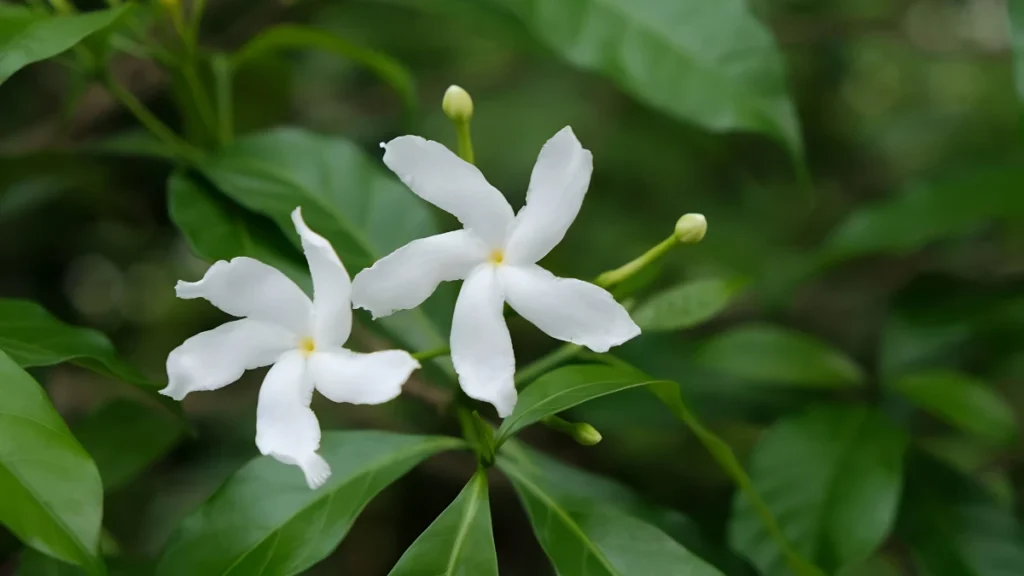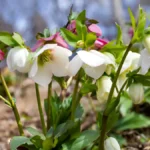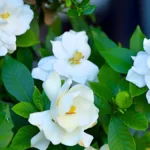With almost 200 types of jasmine, this is a fragrant blooming plant that is mostly found in tropical and subtropical climates. Common varieties include Arabian jasmine (Jasminum sambac), which is distinguished by its star-shaped white blooms and delicious aroma, and Winter jasmine (Jasminum nudiflorum), which is distinguished by its yellow blossoms and capacity to bloom in the colder months. However, the enormous, delicate blossoms of the Spanish jasmine (Jasminum grandiflorum) are prized for their usage in essential oils. Every variety has special qualities and is prized for its aroma and beauty. Continue reading to learn about the many types of jasmine and their attributes.
Listed below are different types of jasmine flowers:
1. Common Jasmine (Jasminum officinale)
- Description: A white, star-shaped vine that is deciduous or semi-evergreen and is prized for its very scented blossoms.
- Origin: Native to the Himalayas, western China, Afghanistan, Pakistan, northern Iran, and the Caucasus.
- USDA Hardiness Zones: 7 through 10; protected zone 6
- Uses: Commonly grown for its aroma, this plant is added to teas and fragrances.
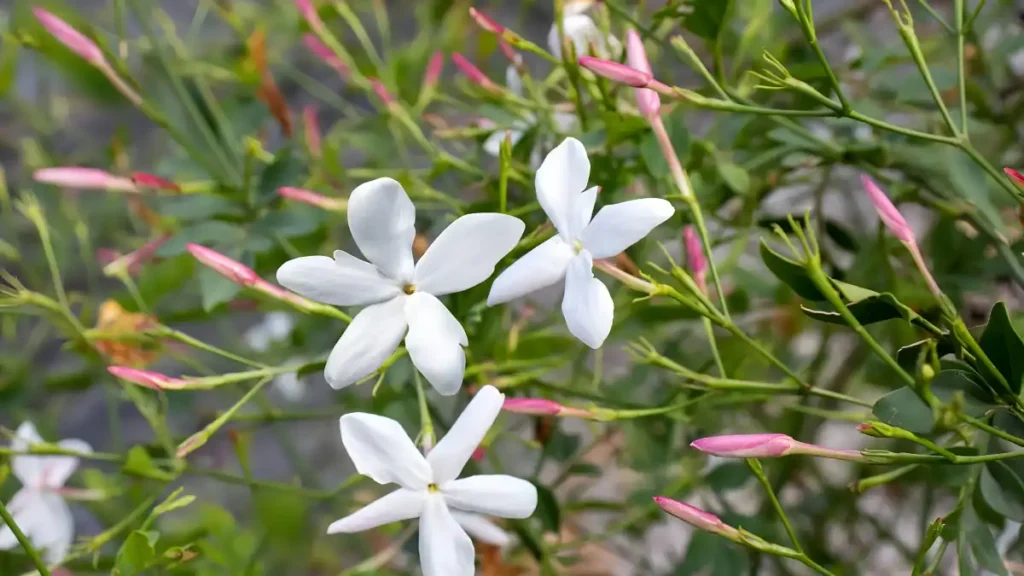
2. Arabian Jasmine (Jasminum sambac)
- Description: In warm areas, this evergreen shrub or vine blooms all year with extremely scented white flowers.
- Origin: Asia, specifically South and Southeast.
- Zones of USDA Hardiness: 9 to 11
- Uses: Jasmine tea and traditional garlands are made from blooms, which are the national flower of Indonesia and the Philippines.
3. Winter Jasmine (Jasminum nudiflorum)
- Description: Bright yellow, non-fragrant blooms bloom from late winter to early spring on a deciduous shrub.
- Origin: China is the native home.
- Zones of USDA Hardiness: 6 to 10
- Uses: Well-liked decorative plant that brightens winter gardens with its early-blooming blooms.
4. Italian Jasmine (Jasminum humile)
- Description: A pleasantly scented yellow flower cluster on an evergreen shrub or vine.
- Origin: Indigenous to China, the Himalayas, Afghanistan, Pakistan, Nepal, and Burma.
- Zones of USDA Hardiness: 7 to 9
- Uses: Grown for aesthetic purposes; excellent for borders and pots.
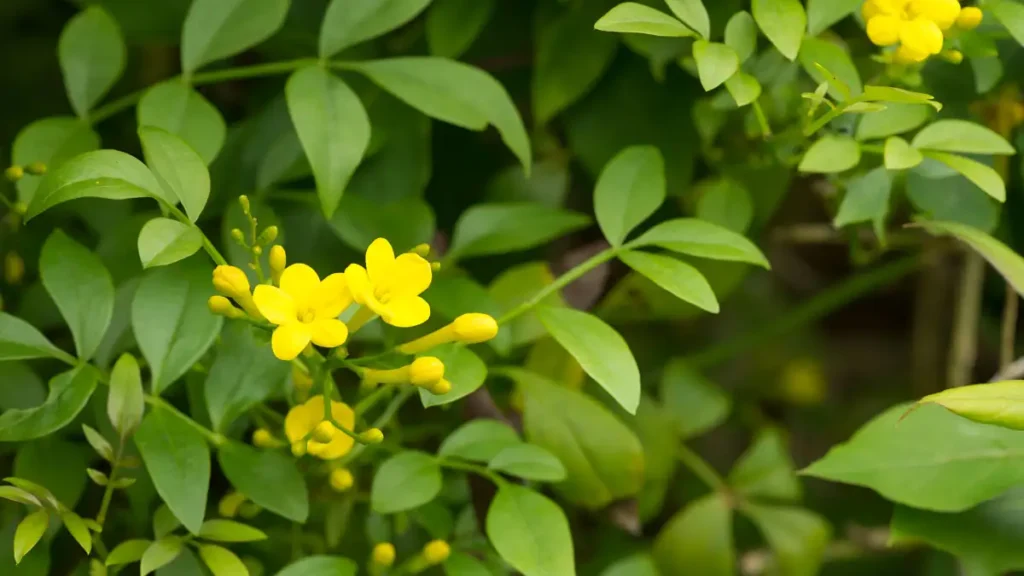
5. Pink Jasmine (Jasminum polyanthum)
- Description: This robust evergreen climber produces masses of pink buds that bloom to fragrant white flowers.
- Origin: Indigenous to Myanmar and China.
- Zones of USDA Hardiness: 8 to 11
- Uses: Because of its powerful perfume and profusion of blossoms, this plant is popular as a climber in gardens and as a houseplant.
6. Forest Jasmine (Jasminum abyssinicum)
- Description: Beautiful white blooms and glossy foliage adorn this aromatic climbing shrub.
- Origin: From East Africa, originally.
- Zones of USDA Hardiness: 8a–11b
- Uses: Rarely grown; prized in its homeland for its aroma.
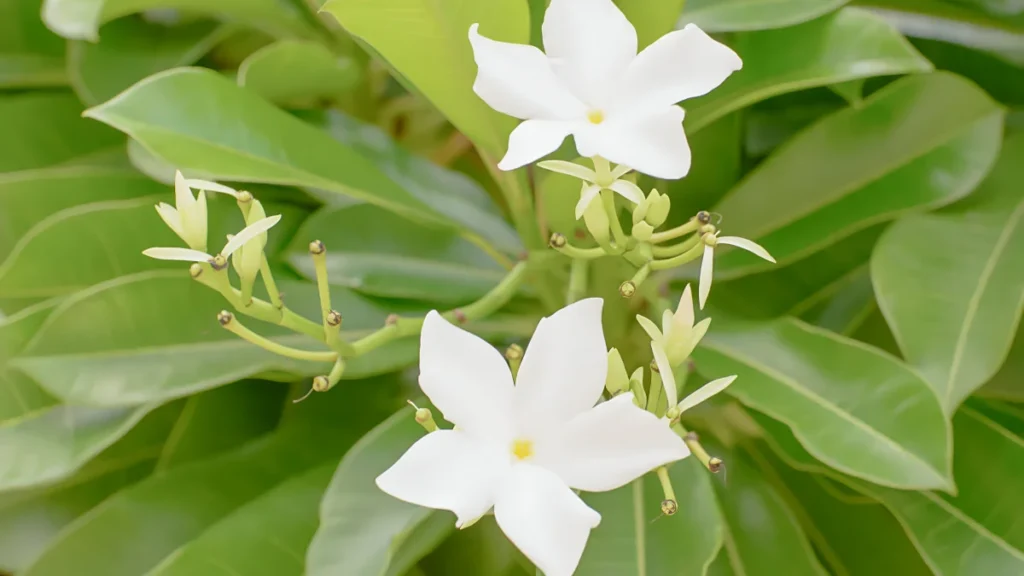
7. Dwarf Jasmine (Jasminum parkeri)
- Description: A tiny, compact-growing evergreen shrub with yellow blooms.
- Origin: Originally from India.
- USDA Hardiness Zones: 9 to 10, yet in mild climates, they could also flourish in zones 6 to 8.
- Uses: Perfect for compact places; great for rock gardens and containers.
Selecting the proper types of jasmine for your garden:
Take into account the following elements while choosing a jasmine plant:
- While some jasmines grow best in warmer areas, some are more tolerant of cold.
- Choose a shrub or a climbing vine depending on your available area and support systems.
- Jasmines that are deciduous lose their leaves in the winter, whereas evergreen varieties keep their leaves throughout the year.
- While some types bloom in the spring or summer, some do so in the winter.
- Although many jasmine species are recognized for their fragrant blossoms, several have non-fragrant flowers.
Conclusion:
Gardeners and plant lovers have a wide variety of alternatives when it comes to jasmine blooms. There is a type of jasmine that fits practically every taste and environment, whether you prefer the traditional scent of the common jasmine or the vivid yellow flowers of the winter jasmine. Enjoy the beauty and fragrance these plants provide to your space by making sure you always select the appropriate types of jasmine flowers for your unique requirements.
Certainly! If you’d like to learn more, please consider following our WhatsApp Channel: Harvest Gardening
A frequently asked questions:
Q1: Which types of jasmine is most fragrant?
A1: The Arabian jasmine (Jasminum sambac), which is the most fragrant kind, is used frequently in fragrances and teas due to its rich, sweet aroma. The common jasmine (Jasminum officinale) is another extremely fragrant species.
Q2: What type of jasmine grows in India?
A2: Common varieties of jasmine found in India are Jasminum grandiflorum, or Spanish jasmine, which is commonly used in fragrances and for religious reasons, and Jasminum sambac, or Arabian jasmine, which is prized for its fragrant white blossoms.
Q3: What is the difference between jasmine and star jasmine?
A3: While star jasmine, or Trachelospermum jasminoides, is a distinct species that is related to the dogbane family but has a scent similar to that of jasmine, it is a fragrant flowering plant genus with star-shaped blossoms. These are not real jasmines, despite the name.

